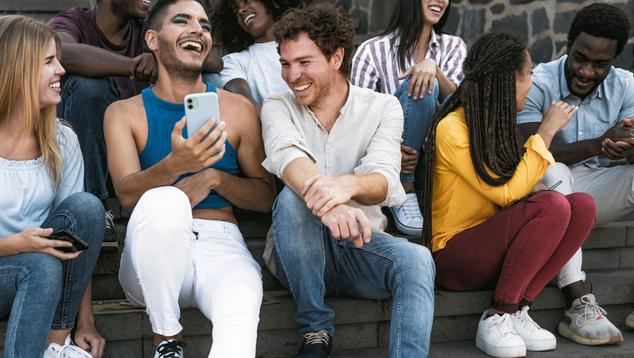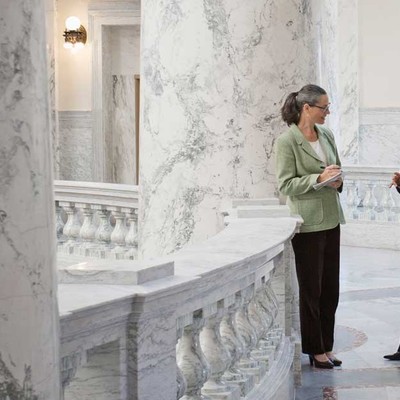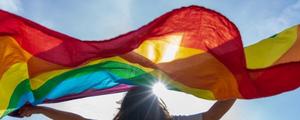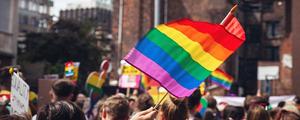WASHINGTON, D.C. -- Today’s young LGBTQ+ Americans report having come out nearly a decade earlier than LGBTQ+ seniors, reflecting societal shifts in greater acceptance that LGBTQ+ adults report having seen over the past decade. Despite this increased acceptance, about one in four report experiences of discrimination in the past year.
These new findings -- from a probability-based Gallup Panel™ survey of gay, lesbian, bisexual, transgender adults and those who identify as something other than non-heterosexual or cisgender, conducted online May 1-15 -- provide more context about LGBTQ+ Americans’ experiences.
Most LGBTQ+ People Came to Terms With Their Identity by Age 18
Most LGBTQ+ adults report that they knew they were LGBTQ+ when they were young, including 48% saying they knew by the age of 14 and 72% coming to the realization by the age of 18. The median age that LGBTQ+ Americans report recognizing their identity is 14.
While the median age that LGBTQ+ adults in the 18-to-29 age group knew they were LGBTQ+ is 14, it is 15 for those in the 30-to-49 and 50-to-64 age groups and 16 for those aged 65 and older.
A Majority of LGBTQ+ Adults Came Out by the Age of 22
After coming to terms with their own identity, most LGBTQ+ adults, 71%, report having come out to others before they turned 30, including 57% who did so by the age of 22. Ten percent say they came out later in life -- in their 30s (7%), in their 40s (2%), or at age 50 or older (1%). Eighteen percent of LGBTQ+ respondents say they have never come out to anyone.
The youngest LGBTQ+ adults, those aged 18 to 29, came out at a median age of 17, while those aged 30 to 49 and 50 to 64 came out in their early 20s. The median age adults aged 65 and older came out is 26.
Comparing the medians for each age group of when they knew they were LGBTQ+ and when they came out to others, young adults were not out to others for the shortest time before coming out (three years), while senior citizens were not out to others for the longest (10 years).
Despite these generational differences, the three youngest age groups are most likely to report having come out between the ages of 19 and 22. This contrasts with adults aged 65 and older, who are most likely to report having come out later in their 20s.
While only 5% of gay or lesbian Americans report they have not come out to anyone, about one in four bisexual adults (23%) remain not out to others. Due to sample size limitations, Gallup is not able to report the experiences of transgender Americans.
Though the median age both LGBTQ+ men and women came out is 19, LGBTQ+ women are more than twice as likely (14%) as LGBTQ+ men (6%) to report having come out by the age of 14.
Most Say Societal Treatment of LGBTQ+ People Has Improved
Seventy percent of both LGBTQ+ adults and U.S. national adults say that societal acceptance and treatment of LGBTQ+ people has “gotten a lot” or “gotten a little” better in the past 10 years. LGBTQ+ Americans of all age groups broadly agree on this point, though younger groups are slightly more likely to perceive positive changes in society’s acceptance.
Meanwhile, one in five LGBTQ+ adults say society’s treatment of LGBTQ+ people has “gotten a lot” or “gotten a little” worse.
About One in Four LGBTQ+ Adults Report Poor Treatment, Harassment in Past Year
Reflecting on their own experiences, about one in four LGBTQ+ adults in the U.S. say they have received poor treatment or harassment “frequently” (5%) or “occasionally” (19%) because of their sexual orientation in the past year. This includes more than a third of gay or lesbian Americans (36%) versus 20% of bisexual adults.
Less than half of all LGBTQ+ adults, 45% -- and 28% of gay or lesbian adults -- say they have not experienced any poor treatment in the past year.
Two in three LGBTQ+ adults (66%) say the mistreatment they have experienced has been “about the same” in the past year compared with previous years. They are about as likely to say they have received more (15%) than less mistreatment (18%) in the past year as in prior years. However, gay or lesbian people (24%) are twice as likely as bisexual people (12%) to say they have received more poor treatment or harassment in the same period.
Bottom Line
Americans, like residents of other countries, have significantly changed in terms of the way they view LGBTQ+ people, including their perceptions of the morality of same-sex relations and views on LGBTQ+ rights in the U.S. -- and LGBTQ+ people themselves acknowledge this increase in acceptance.
As society has shifted in its views and treatment of this group, it has had little bearing on the timing when LGBTQ+ Americans became aware of their own personal identity, but it has had a great impact on when these individuals have chosen to share their identity with others. LGBTQ+ seniors came out nearly a decade later in life than today’s young LGBTQ+ adults.
Still, societal changes are no guarantee against discrimination, which one in four LGBTQ+ adults report having experienced in the past year and gay or lesbian people, in particular, are vulnerable to experiencing.
To stay up to date with the latest Gallup News insights and updates, follow us on X @Gallup.
Learn more about how the Gallup Panel works.





